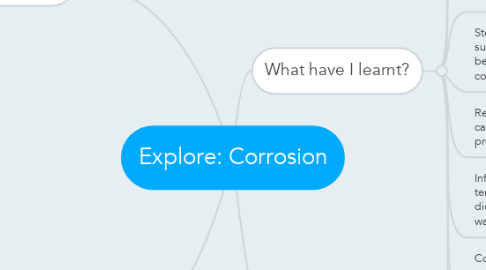Explore: Corrosion
Door Jessica Perry


1. What do I know?
1.1. Some methods to stop corrosion are: painting, galvanising, sacrificial protection, oiling and plastic coating.
1.2. The more reactive a metal the more likely it is to corrode. Sodium is very reactive and so it corrodes very easily. Copper is not so reactive and therefore takes longer to corrode. That is why it had historically been used for buildings, pipes and statues.
1.3. Any method that stops the water, oxygen or salt from reaching the metal is a good preventative of corrosion.
1.4. Corrosion is the reaction of a metal with oxygen in its environment (water, salt) to form a meta oxide.
1.5. Rust is a type of corrosion referring to the specific case of iron (or steel which is mostly made of iron) corroding.
1.6. Water and salt act as catalysts to help break apart the bonds in the metal and allow it to react with the oxygen. If the metal is kept somewhere dry and not salty it will experience minimal corrosion.
2. What do I want to know?
2.1. How might corrosion be prevented as a result of this?
2.2. Types of environmental factors specifically affecting buildings, bridges, etc.
2.3. What materials are used in construction? How does this affect corrosion levels? (can any be used in replacement to prevent corrosion?)
2.4. Why is steel sheeting and reinforced concrete degrading?
3. What have I learnt?
3.1. Concrete cancer --> the worse it gets the faster it corrodes
3.2. Corrosion may be prevented by:
3.2.1. Measure expected corrosion levels and design with these in mind
3.2.2. Hot dip galvanising
3.2.3. Electrogalvanizing
3.2.4. Metallic Spraying
3.2.5. Painting

